NYC’s Forgotten ‘War on Christmas Trees’
Discover how an obscure holiday crackdown affects festive street vendors today!


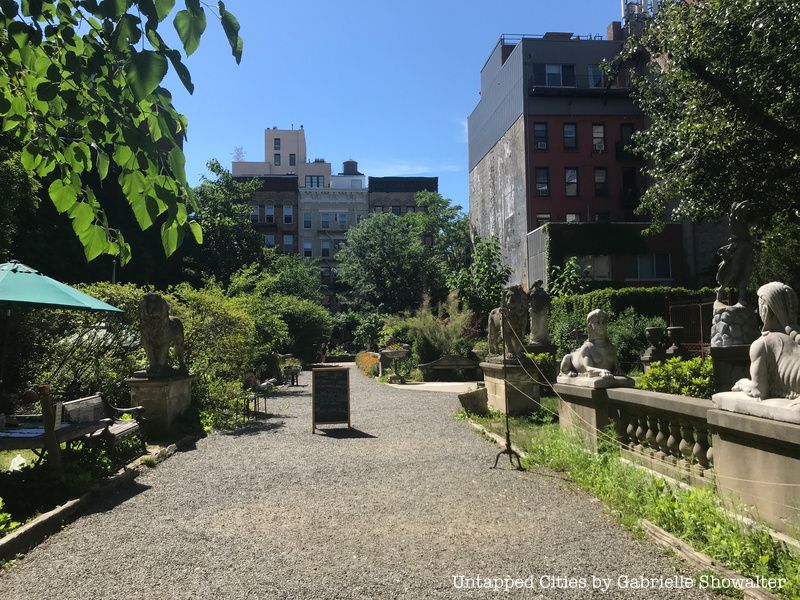
When it comes to green spaces in New York, you might immediately think of Central Park or Prospect Park, with their lush lawns and expansive views. But there are other green gems tucked away within the folds of the city, perfect for slipping away from the bustle of New York for a few minutes (or hours). Best of all, most of these gorgeous spaces are free to visit.
These spots combine the relaxed atmosphere of large parks with the coziness of small communities, and feel far away from the activity of city life, even though as exist within it. From secret rooftop terraces to waterfront oases and lively community gardens, here are some of the best secluded urban green spaces in New York City.
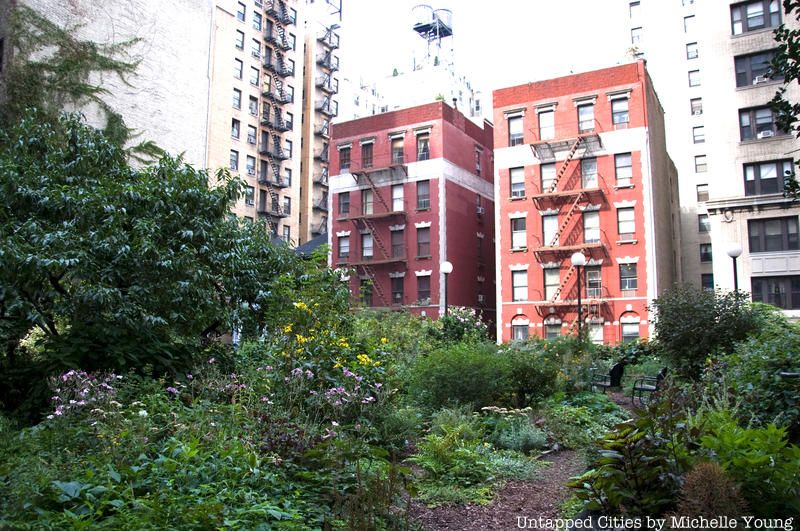
Once upon a time this plot was merely a condominium garage roof, but now it’s a thriving community garden. Lotus Garden, on the Upper West Side’s 97th street, between Broadway and West End Avenues, is one of New York’s first green roofs, and has tall shrubbery, fruit trees, a green wall, flowers, two goldfish ponds, and views of the colorful townhouses across the street.
In the late 1980’s, community organizers joined to form a committee whose goal was to create a tranquil green space out of an unused roof. Thirty years later, the 1/6th of an acre garden is flourishing thanks to its community members, whose $20/year membership fees help maintain the gardens and plots.
Though it is accessible 24/7 to members, it is open to the public every Sunday from 1-4 PM
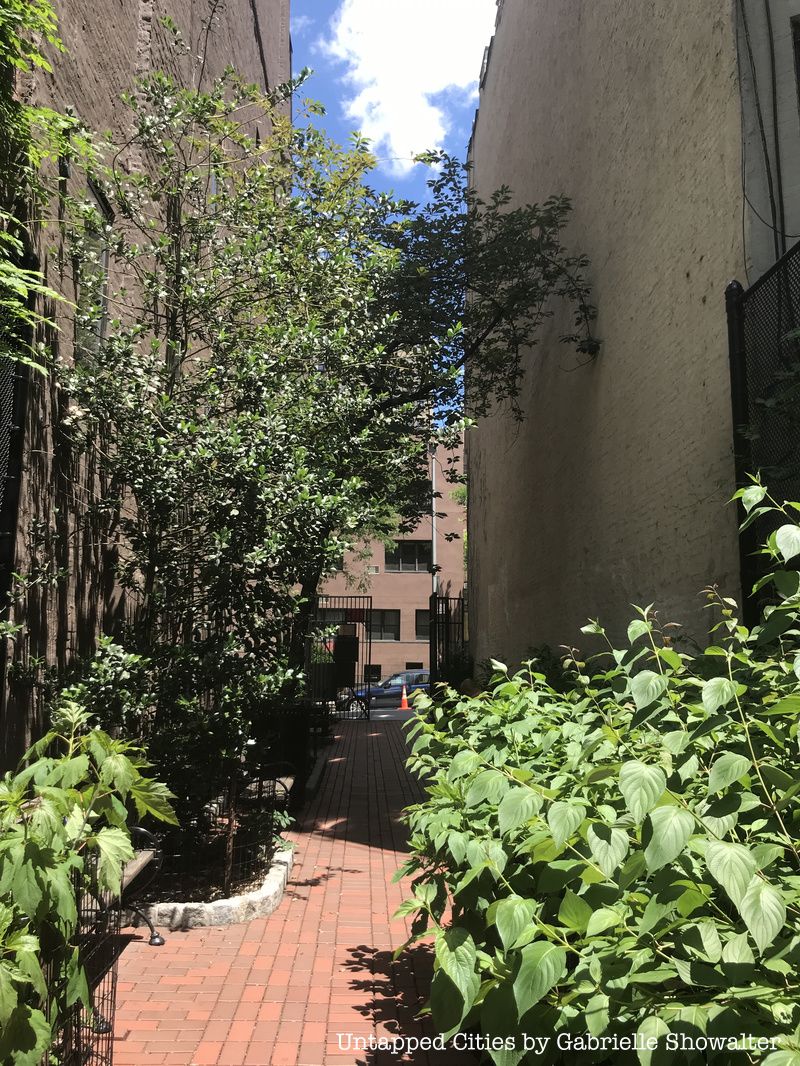
You really can’t get more secluded than a park built in an alleyway. Septuagesimo Uno is a tiny public park tucked in between brownstones on the Upper West Side, at 71st between West End and Amsterdam Avenues. Comprising of a two-fifths-of-an acre plot of land, a few benches, and planted greenery, it’s one of the smallest parks in the city, and is a tranquil (and hidden) space to spend a lunch break or catch your breath.
Septuagesimo Uno was originally an empty lot, but through Mayor Lindsay’s “Vest Pocket Park” campaign in the 60’s (designed to create small parks within the gridwork of the city), it was developed into a small, shady park. The park’s name–Septuagesimo Uno–is actually a nod to the street it was built on; Septuagesimo Uno is Latin for “Seventy-One”.
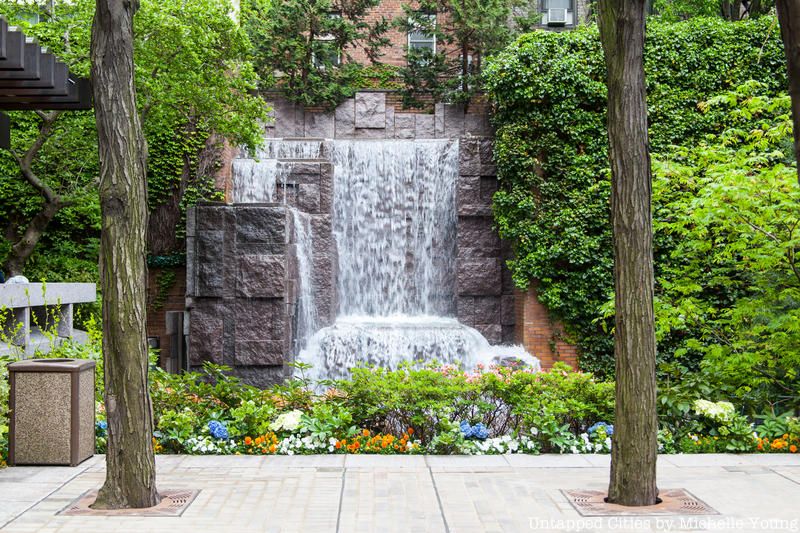
Another vest pocket park of New York, Greenacre is perhaps best known for its 25-foot high waterfall, which provides the atmosphere of a dramatic oasis to visitors and drowns out the noise of the city. Located in Midtown, on East 51st between 2nd and 3rd Avenues, the small park opened in 1971 and was modeled after the nearby Paley Park (which also features a waterfall). It includes both a main square and an elevated patio-like area, both with views of the waterfall.
The park was recently under threat from the New York City Council’s recent rezoning decision to allow for construction of taller buildings, which would increase shadows cast over the park. The concern was mostly for the honey locust trees planted in the park, as they are extremely light-sensitive and would not thrive without adequate sunlight.
This resulted in the Greenacre Park’s “Fight for Light” campaign, which was unsuccessful in its goal to get official protection for the Park’s sunlight. However, the NYC Department of City Planning has agreed to meet with the Greenacre Foundation concerning shadow impact of the redevelopment.
Greenacre Park is open in the summer from 8AM-8PM, from 8AM-6PM during the rest of the year, and is always free to visit.
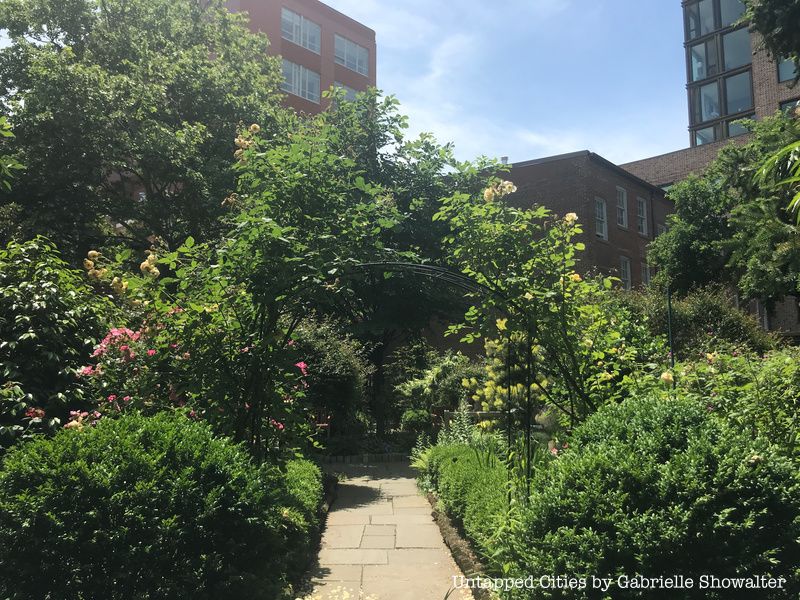
Located between Hudson and Christopher Street in the West Village is a historic and picturesque church garden. With winding pathways filled with lavender, roses, tulips, and more, it is the ideal oasis in which to spend an afternoon.
The very first seed was planted in the garden in 1842 from an English Glastonbury Thorn, and survived until struck down by a windstorm in 1990. The garden’s plants have continued to flourish since its construction; a visit to the gardens will reveal a dazzling array of multi-colored flowers, and wildlife lovers will be able to spot birds and butterflies amongst the shrubbery.
Owned and maintained by the Church of St. Luke in the Fields, the garden consists of more than two-thirds of an acre of land containing a colorful variety of flora, trees, and shrubbery. It is open and free to the public from 10AM until dusk every day except Sunday, when it closes at 6:30PM.

Down in Nolita, Elizabeth Street Garden is a privately owned, publicly enjoyed community sculpture garden. With garden plots, marble statues, and flowering plants interspersed with benches, visitors are seemingly transported from the city streets to a picturesque storybook-setting.
First developed in 1981, it opened to the public in 2005, and has become an important space for the community, as the gardens often plays host to neighborhood art exhibitions, small festivals, and yoga and exercise classes.
The garden is in serious danger of being destroyed, as the city has plans to demolish most of the park to build a new housing development, and the garden as it exists now would be gone. Community members and activists of the Elizabeth Street Garden have united to form an organization that continues to work to keep the garden open. The organization released an alternative plan and renderings for the garden in January.
In the meantime, you can support the garden simply by visiting it, or by donating to the cause to keep it open. Elizabeth Street Garden is open from 12-5 PM Monday-Friday, and 10-5 PM on weekends.
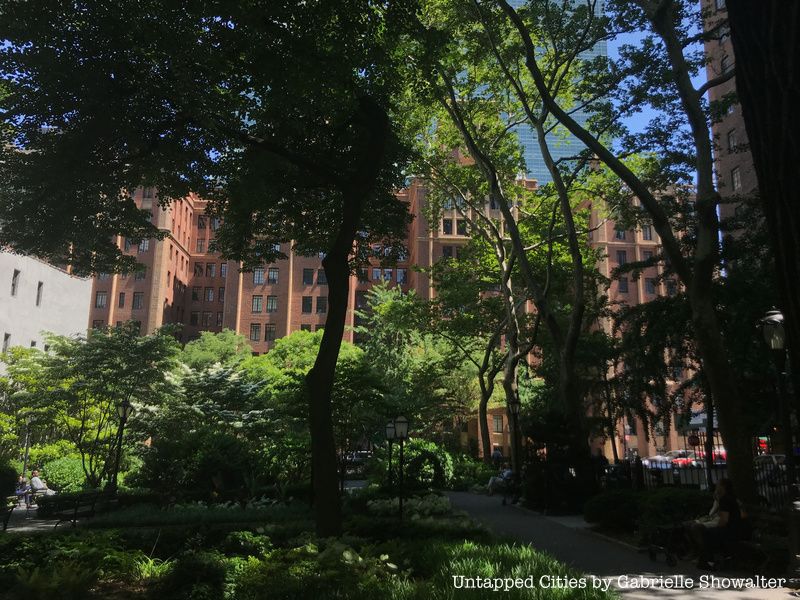
The best word to describe Tudor City Greens? Charming. From the carefully manicured grounds to the flower gardens, bird baths, benches, street lamps, and location looking over East 42nd Street and 2nd Avenue, it feels almost like someone planted a small-town garden right in the middle of Turtle Bay. It’s an elevated park, accessible by steps on East 42nd Street.
Tudor City Greens is unique in that the founder of the Tudor City community, a twentieth-century real-estate developer Fred F. French, oriented the residential buildings around Tudor City Greens, rather than enclosing the gardens within a private courtyard, as seen in New York’s turn-of-the-century Astor courtyard buildings. During the 1920’s when French implemented his plan, the idea of centering a neighborhood around a park while also making it accessible to the public rather than enclosing it inside a courtyard was new.
Run by a non-profit organization consisting of local Tudor City community members, the park is open to the public daily from 7AM to 10PM, free of charge.

Walking into Teardrop Park in Battery Park City between Warren and Murray Streets, you would be forgiven for thinking you have somehow been transported to upstate New York. Filled with trees, plants, and rocks, it has become a haven for wildlife and visitors alike.
The park has been praised for its architecture, which incorporates sedimentary rock from New York State as naturalistic seating areas, as well as sand pits, a playground built into the rocks, a children’s path with water features, a tunnel to connect different areas of the park, a lawn for sunbathing, and plenty of shade from planted trees. The only giveaway that you’re still in Manhattan is the high-rise residential buildings peeking through the trees.
It’s hard to believe that before the park’s opening in 2004, the area was completely flat. The park’s design was done by architectural firm Michael van Valkenburg Associates Inc, with sustainability in mind; the park is irrigated by recycled water and stormwater runoff, and the plants are maintained through routines that don’t use harmful herbicides and pesticides. The park is open 24 hours, but you’ll have to leave your pets at home–dogs aren’t allowed in this park.
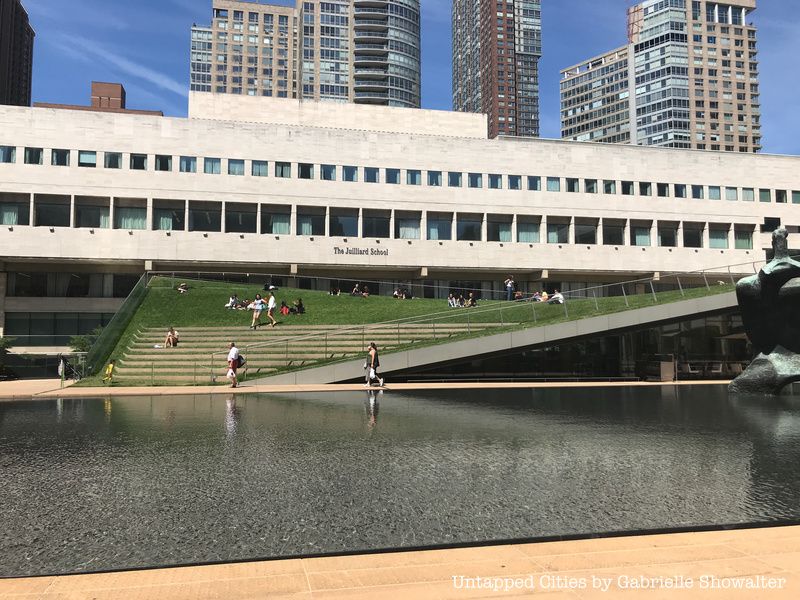
Imagine lounging in the grass of a rolling green hill. Now imagine that hill has panoramic views of Manhattan’s Upper West Side, and is located on top of the restaurant, Lincoln. This is the Laurie M. Tisch Illumination Lawn, a sloped, triangular-shaped building in the middle of Lincoln Center. The roof-park hybrid opened as part of Lincoln Center’s $1.2 billion renovation project, the angled green lawn is accessible to the public free of charge, by steps built into the structure.
As a small and elevated green space, it gives an impression of solitude even amongst the traffic nearby. You wouldn’t think that a lawn in the bustling Lincoln Center could feel secluded, but its elevation and birds-eye view down West 65th Street help to make it feel like a private place.
The grass is kept in place by a permeable plastic cellular mat called a geoweb, and the lawn is named after Laurie M. Tisch, a philanthropist and the project’s main donor. It’s a great space to lounge, tan, picnic, or just relax in.
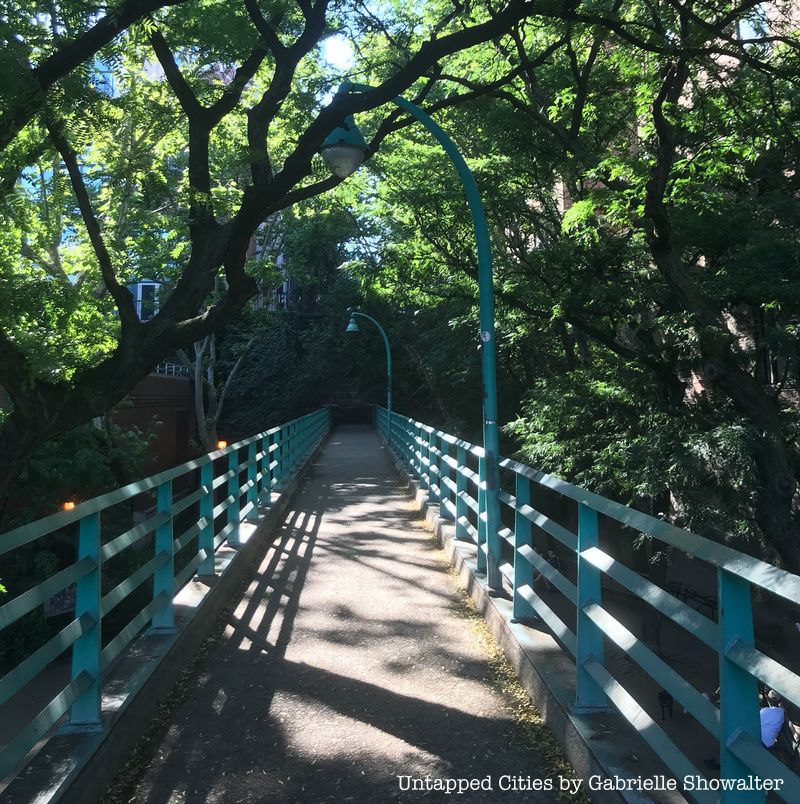
If you’re looking for gorgeous waterfront views, a dog-friendly area, or even just a place to play chess, Peter Detmold Park is for you. Invisible from street-level, the park sits at the waterfront edge of FDR Drive, and includes a footbridge, gazebo, chess tables, a dog run, and views across the East River.
The park is named after WWII vet and former Turtle Bay resident Peter Detmold, who was killed while walking home in 1972. Detmold was an advocate for the neighborhood, as both the founder of the Turtle Bay Gazette, and president of the Turtle Bay Association. Though the park was named after Detmold immediately after his death, ground didn’t break on the current park until the late 1980’s, when residents rallied to restore the park, using $794,000 to implement new asphalt, the gazebo, a wooden entranceway, and more.
The park is free for all and open from 6AM-8PM year-round.
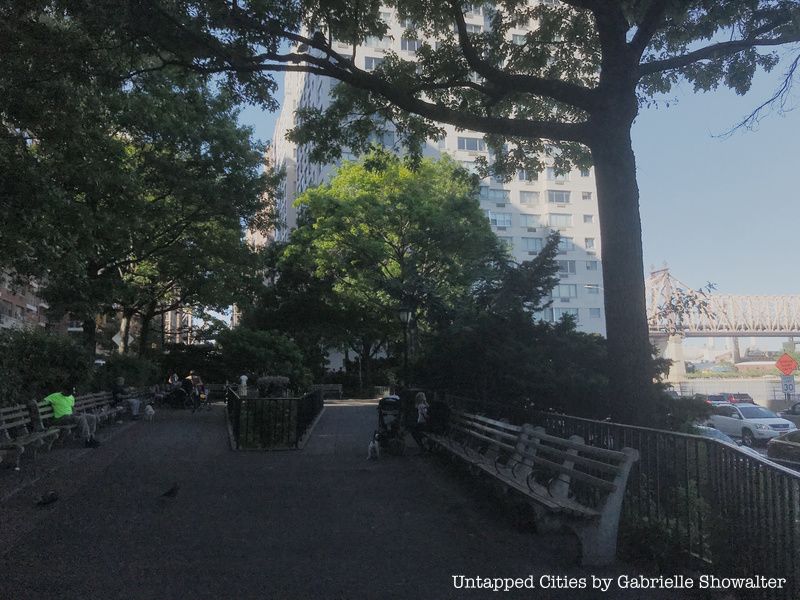
Just a few streets up from Peter Detmold Park lies another waterfront green space, Sutton Place Park. It is probably best-known for its appearance in Woody Allen’s 1979 film Manhattan, and it’s not difficult to imagine why–the park’s views of the Queenborough Bridge and East River are positively cinematic. With its riverside park benches, manicured grass, and tall trees, it’s a wonderful spot to relax.
The park also has a storied history. It’s named after Effingham B. Sutton, an entrepreneur who got his fortune during the California Gold Rush and set up brownstones in the area to form a residential community in 1875. However, poverty and violence struck the neighborhood, so by 1900, the waterfront area had become known for its gang violence.
As wealthy families like the Vanderbilts and Morgans moved into the area in 1920, the neighborhood transformed to become wealthy and residential. After the construction of FDR Drive in the 1930’s, Sutton Place Park was built.
While you’re there, make sure to check out the bronze boar statue in the middle of the park–it’s a replica of Renaissance sculptor Pietro Tacca’s “Porcellino”, in Florence, Italy.
Want to check out more green spaces around NYC? Take a look at 10 of the smallest parks in NYC and the Secret Garden on the Roof of the Starrett-Lehigh Building in NYC.
Subscribe to our newsletter